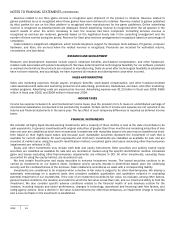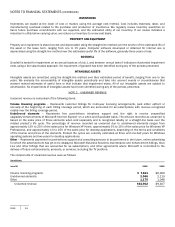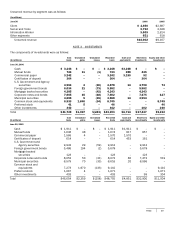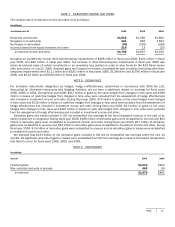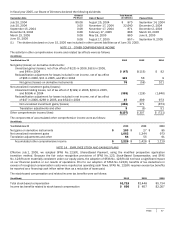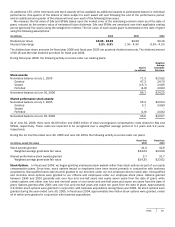Microsoft 2006 Annual Report Download - page 56
Download and view the complete annual report
Please find page 56 of the 2006 Microsoft annual report below. You can navigate through the pages in the report by either clicking on the pages listed below, or by using the keyword search tool below to find specific information within the annual report.
PAGE 55
The components of the deferred tax assets and liabilities were as follows:
(In millions)
June 30
2006
2005
Deferred income tax assets:
Stock-based compensation expense
$ 3,630
$
3,994
Other expense items
1,451
1,751
Unearned revenue
1,028
915
Impaired investments
989
861
Other revenue items
102
213
Other
–
173
Deferred income tax assets
$ 7,200
$
7,907
Deferred income tax liabilities:
International earnings
$(1,715
)
$(1,393)
Unrealized gain on investments
(801
)
(1,169)
Other
(133
)
(23)
Deferred income tax liabilities
(2,649
)
(2,585)
Net deferred income tax assets
$ 4,551
$
5,322
Reported as:
Current deferred tax assets
$ 1,940
$
1,701
Lon
g
-
t
erm deferred tax assets
2,611
3,621
Net deferred income tax assets
$ 4,551
$
5,322
Deferred income tax balances reflect the effects of temporary differences between the carrying amounts of assets and liabilities
and their tax bases and are stated at enacted tax rates expected to be in effect when taxes are actually paid or recovered.
We have not provided deferred U.S. income taxes or foreign withholding taxes on temporary differences of approximately
$505 million resulting from earnings for certain non-U.S. subsidiaries which are permanently reinvested outside the United
States. The amount of unrecognized deferred tax liability associated with these temporary differences is approximately $151
million.
The American Jobs Creation Act of 2004 (the “Act”) was enacted in October 2004. The Act creates a temporary incentive for
U.S. corporations to repatriate foreign subsidiary earnings by providing an elective 85% dividends received deduction for certain
dividends from controlled foreign corporations. Under these provisions, we repatriated approximately $780 million in dividends
subject to the elective 85% dividends received deduction and we recorded a corresponding tax provision benefit of $179 million
from the reversal of previously provided U.S. deferred tax liabilities on these unremitted foreign subsidiary earnings in 2005.
The dividend was paid in June 2006.
Income taxes paid were $4.8 billion in fiscal year 2006, $4.3 billion in fiscal year 2005, and $2.5 billion in fiscal year 2004.
Tax Contingencies. We are subject to income taxes in the United States and numerous foreign jurisdictions. Significant
judgment is required in determining our worldwide provision for income taxes and recording the related assets and liabilities. In
the ordinary course of our business, there are many transactions and calculations where the ultimate tax determination is
uncertain. We are regularly under audit by tax authorities. Accruals for tax contingencies are provided for in accordance with the
requirements of SFAS No. 5, Accounting for Contingencies.
Although we believe we have appropriate support for the positions taken on our tax returns, we have recorded a liability for
our best estimate of the probable loss on certain of these positions, the non-current portion of which is included in other long-
term liabilities. We believe that our accruals for tax liabilities are adequate for all open years, based on our assessment of many
factors including past experience and interpretations of tax law applied to the facts of each matter, which matters result
primarily from inter-company transfer pricing, restructuring of foreign operations, tax benefits from the Foreign Sales
Corporation and Extra Territorial Income tax rules, the amount of research and experimentation tax credits claimed, state
income taxes, and certain other matters. Although we believe our recorded assets and liabilities are reasonable, tax regulations
are subject to interpretation and tax litigation is inherently uncertain; therefore our assessments can involve both a series of
complex judgments about future events and rely heavily on estimates and assumptions. Although we believe that the estimates



